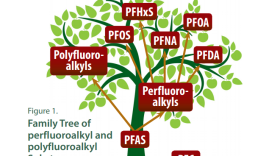New York Senator Kirsten Gillibrand is introducing a bill to place more restrictions on firefighting foams containing PFAS chemicals.
Senator Gillibrand on Wednesday announced the PFAS Firefighter Protection Act. Michigan Congressman Dan Kildee, a fellow Democrat, is introducing a companion bill in the House.
PFAS substances, linked to several ill health effects including cancer, are used as an ingredient what is referred to as aqueous film forming foam – or AFFF.
On a virtual press conference Wednesday afternoon, Gillibrand said the new bill follows similar legislation passed three years ago.
“You may be aware that in 2019 we passed a ban on the use of PFAS-containing firefighting foams on military bases. So, you may be wondering why this legislation is still needed. The truth is, that 2019 law did not affect these PFAS chemicals in other areas, particularly on training sites. My bill goes one step further to ban all manufacturing, importation, and sale under the Toxic Substances Control Act,” said Gillibrand.
The military use of firefighting foam has been linked to contamination of drinking water supplies, including in Lake Washington, the former drinking water supply for Newburgh, New York.
Representative Kildee explained that commercial airports – not just military – also used AFFF containing PFAS.
“Before 2018, under the law, commercial airports – mirroring, then-military regulations – were required to use PFAS in firefighting foam, and as a result, PFAS contaminated drinking water for people that live near airports and near military bases. Where there was once a strong need for firefighting foam containing PFAS, let’s be clear, there are now alternatives to PFAS in firefighting foam.”
Kildee said testing has shown firefighters have significantly higher levels of PFAS in their blood than the general population.
Liz Hitchcock, Director of Safer Chemicals Healthy Families, joined the officials on the call.
“Firefighters and communities are paying for this pollution with our health and our taxpayer dollars. But fluorine-free foams are available and in use around the world with more and more entering the marketplace. It’s past time for the federal government to ban these dangerous toxic foams. It’s long-past time to protect firefighters and the communities they protect,” said Hitchcock.
Edward Kelly, General President of the International Association of Fire Fighters, wants to take action to restrict the use of PFAS chemicals beyond firefighting foam.
“We need to take these chemicals on a grand scale. We need to change the paradigm for the next generation: not just for firefighters, but for everybody,” said Kelly.
Last year, the House passed the so-called PFAS Action Act.
The bill requires the Environmental Protection Agency to classify PFAS compounds PFOA and PFOS as hazardous substances under the federal Superfund program.
In restricting two specific compounds, the bill has been characterized by environmentalists as too small a step. PFAS includes thousands of largely unregulated chemicals used in consumer products.
The PFAS Action Act has been sent to the Senate’s Committee on Environment and Public Works.
Gillibrand hopes the bill will get an up-or-down vote.
“Being able to ban it outright is our ultimate goal, and so the House bill would do that. And so we want to try to get it done through the EPW Committee here and they’re reviewing it. So, they haven’t done it yet, but we are pushing,” said Gillibrand.





